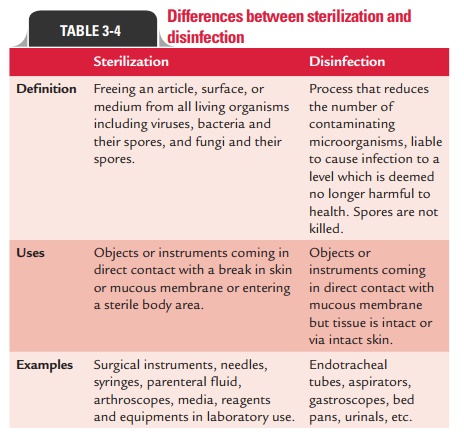Chapter: Microbiology and Immunology: Sterilizationand Disinfection
Disinfection
Disinfection
Disinfection is the process of inactivating microorganisms by direct exposure to chemical or physical agents. Differences between sterilization and disinfection have been summarized in Table 3-4.
Disinfectants are products or biocides that destroy orinhibit the growth of microorganisms on inanimate objects or surfaces. Disinfectants can be sporistatic but are not nec-essarilysporicidal.
Antiseptics are biocides or products that destroy or inhibitthe growth of microorganisms in or on living tissue.
Antiseptics and disinfectants are used extensively in hospitals for a variety of topical and hard surface applications. They are an essential part of infection control practices and aid in the prevention of nosocomial infections.

Properties of Ideal Disinfectant
An ideal disinfectant or antiseptic has the following characteristics:
1. Ideally, the disinfectant should have a wide spectrum of antimicrobial activity. It must be effective against a wide variety of infectious agents (Gram-positive and Gram-negative bacteria, acid-fast bacteria, bacterial endospores, fungi, and viruses) at high dilutions.
2. It should act in the presence of organic matter.
3. It should not be toxic to human or corrosive. In prac-tice, this balance between effectiveness and low toxicity for animals is hard to achieve. Some chemicals are used despite their low effectiveness, because they are relatively nontoxic.
4. It should be stable upon storage and should not undergo any chemical change.
5. It should be odorless or with a pleasant odor.
6. It should be soluble in water and lipids for penetration into microorganisms.
7. It should be effective in acidic as well as in alkaline media.
8. It should have speedy action.
9. If possible, it should be relatively inexpensive.
Action of Disinfectants
Disinfectants act in many ways as discussed below.
1. They produce damage to the cell wall and alter permeabil-ity of the cell membrane, resulting in exposure, damage, or loss of the cellular contents.
2. They alter proteins and form protein salts or cause coagu-lation of proteins.
3. They inhibit enzyme action and inhibit nucleic acid syn-thesis or alter nucleic acid molecules.
4. They cause oxidation or hydrolysis.
Factors Influencing Activity of Disinfectants
Various conditions influencing the efficiency of disinfectant are as follows:
Temperature: Increase in temperature increases theefficiency of disinfectants.
Type of microorganism: Vegetative cells are more suscep-tible than spores. Spores may be resistant to the action of disinfectants.
Physiological state of the cell: Young and metabolicallyactive cells are more sensitive than old dormant cells. Nongrowing cells may not be affected.
Environment: The physical or chemical properties of themedium or substance influence rate as well as efficiency of disinfectants, e.g., pH of the medium and presence of extraneous materials.
Related Topics